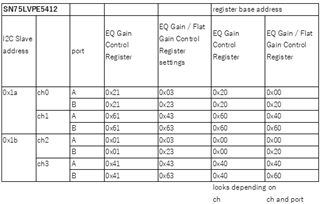Other Parts Discussed in Thread: SN75LVPE5421
Tool/software:
Hello, Ti support team
I am conducting experiments using the ICs SN75LVPE5412 and SN75LVPE5421, changing the EQ Gain and Flat Gain settings.
Could you please tell me the register addresses used when configuring these two settings via I2C communication?
Table 6-5 in the datasheet includes the following information.
Could you explain the differences between addresses 0x00 and 0x20, and between 0x40 and 0x60?
When testing with the actual hardware, it seems that the addresses are used differently depending on whether port A or B is selected, but I couldn't find any mention of this in the datasheet.
If there is any detailed documentation about the Register Base Address, could you please share it with me?
Table 6-5
Channel Registers Base Address
Channel Bank 0 Access Channel Bank 1 Access
0x00 Channel 0 registers Channel 2 registers
0x20 Channel 0 registers Channel 2 registers
0x40 Channel 1 registers Channel 3 registers
0x60 Channel 1 registers Channel 3 registers



